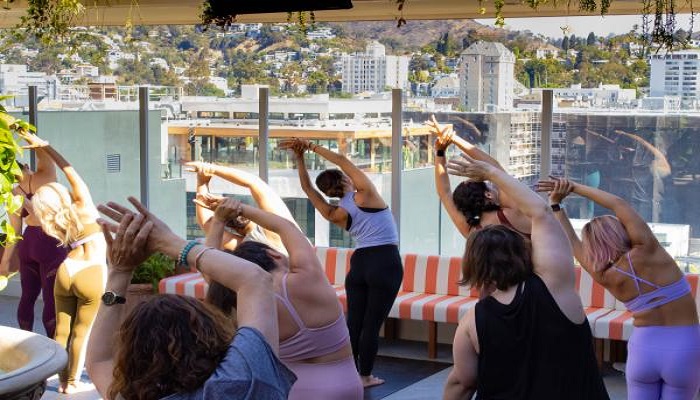Burberry has launched a new scarf and trench collection, created in partnership with Highgrove Gardens, which surround the much-loved private residence of His Majesty King Charles III and Queen Camilla.
The scarf and trench collection marks the third partnership between Burberry and Highgrove and honours the thoughtful, steadfast work of King Charles III and The King’s Foundation, a charity founded by His Majesty which acts as custodian of Highgrove Gardens and offers courses for traditional craft skills on site.
A Crafted Collection - scarf and trench collection
Made in Italy, the four scarves contain organic silk and are finished with hand-rolled edges, ensuring long-lasting quality.
The Castleford trench coat is a new style introduced by Chief Creative Officer Daniel Lee. It is woven from gabardine, an invention by Thomas Burberry in 1879, at our mill in Keighley and is assembled at our factory in Castleford, Yorkshire. The Castleford’s outer uses 100% organic cotton and is available in two colours, hunter and ivy.
British Artistry
As a Royal Warrant holder and British heritage brand, Burberry shares the commitment of The King’s Foundation in supporting young British artists, whilst ensuring the legacy of craft and artistry is passed onto the next generation.
The drawings for the scarves and linings of the trench coats were created by British artist Holly Mills, a graduate of the Royal Drawing School.
Drawn at Highgrove Gardens during the peak of summer’s bloom, Holly’s vibrant illustrations capture the species-rich meadows and delphinium – the favourite flower of His Majesty.
Ahead of the launch of scarf and trench collection, Burberry connected with Holly to discuss her time at the Royal Drawing School, the inspiration behind her illustrations and what Burberry means to her.
Q: Tell us about your creative journey – what led you to become an artist?
For as long as I can remember I’ve always had an urge to ‘make’. Growing up in London, my mum would regularly take us to galleries and museums whilst my dad would be cameraman for elaborate films that my sister, best friend Izzy and I wrote and starred in. I think I’ve always just been encouraged to do what I enjoyed the most. I studied at Camberwell College of Arts before attending the Royal Drawing School in 2017/18 and I feel fortunate to have been able to sustain my art practice since then.
Q: We understand that you’re an alumnus of the Royal Drawing School, which was founded by His Majesty The King. Tell us about your time there and the impact that The Drawing Year had on your work?
I am very grateful to have done The Drawing Year, it came at a time when I was feeling uncertain within my own practice and gave me the confidence to trust my gut a little bit more. Drawing all day, almost every day, for over a year was pretty intense – but it taught me to use drawing as a way of looking at things, of distilling and processing the world, rather than it having to have an end point – this allowed me to fall in love with the process again. Another big thing was meeting so many fellow artists, who continue to inspire and support me.
Q: David Hockney was once quoted saying ‘Drawing helps you to put your thoughts in order. It can make you think in different ways.’ Would you agree with this, and do you think drawing has had the same impact on the way you see the world?
Yes, I do. Whenever I am feeling stuck or lost in my own head in the studio, I find it useful to go back to the basics of drawing from life, as a way of finding my way back to what it is I want to be making. When I get into a drawing, it can feel almost like a form of meditation, allowing me to think more clearly (be less distracted by screens!), to look more intently, and to try to see the thingness of things.
Q: How would you describe your compositions, and are there specific artistic movements that inspire you?
I come from an illustration background and I think that a love for graphic novels (Oliver Schrauwen, Brecht Evens…), strong ‘cartoonish’ lines (big fan of the Chicago Imagists) and divided picture planes still permeates my work today. I’ll forever return to Early Renaissance Italian painting and Mughal Indian miniatures – for their colour, storytelling and geometry of space. I love that ‘tipped up’ feeling, where everything (be it human, animal, building, tree) has a rightful place, and pattern is able to become ‘space’.
Q: We notice that your work often uses a plethora of materials. Do you have a favourite medium?
I’ve recently been enjoying egg tempera and oil pastels – the way they lend themselves to layering and scratching is pleasing. But no, it’s too hard to pick just one! I think that’s part of my process – to not stick to one material, it keeps an element of uncertainty in the act of making, and maybe a freshness too. I love the ‘what will happen if I put this on top of that?’ moments – they’re exciting.
For this commission, I didn’t want to add too much texture as I knew that it would be tricky to reproduce as a printed textile. Limiting myself to inks and dry materials (mostly) was a different kind of challenge and a welcome change of rhythm.
Q: We understand that you spent some time at Highgrove in July to capture the gardens as they bloom for the summer. What was it like being at Highgrove, and were there any particular features or gardens that you especially loved?
I had a really great guide, Rob, who took me around Highgrove for the day and explained how much consideration, care and hard work goes into maintaining each garden. There was a walkway lined with large topiary bushes – each gardener had been given one to tame and shape to their own design as a- a little competition! I liked the contrast between these quite bizarre moments of trimmed hedges against the meadow for its wildness, and the loud hum of the insects.
Q: Four of your artworks from your time at Highgrove have been transformed into silk scarves as well as linings for a Burberry trench coat. Was there a reason why you selected these landscapes and flowers specifically?
I’d been told that King Charles had created a garden for delphiniums – his favourite flowers. The plants were so much taller than I’d imagined, so that on entering the Sundial Garden you are totally surrounded by vivid colours, it’s quite overwhelming! They were a pleasure to draw, I mostly made quick sketches whilst at Highgrove and worked from these, notes, photos, and memory to make the final images back in the studio.
Q: Burberry have a longstanding commitment to celebrating British arts and craft and continue to make their Heritage trenches at their manufacturing sites in Yorkshire. What does it mean to you to see your work appear as the lining of a Burberry trench coat – a garment that undergoes 190 meticulous stitch processes and is, like a piece of art, often handed down through generations?
I always try to treasure clothes by mending and repairing rather than replacing. The thought of contributing to, and owning, something so expertly made, that I can keep forever, and that my children or grandchildren might one day own is very special to me.
Source: Burberry



